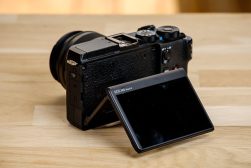
Canon PowerShot G7X Mark III Camera Review
Looking for a compact camera to lift your vlogging game above the limitations of a smartphone? The Canon Powershot G7X Mark III is a great option.
If you’re on the hunt for a new camera to lift your vlogging game above the limitations of a smartphone, then the Canon Powershot G7X Mark III may be perfect for you.
Canon recently released the new G7X Mark III with improved capabilities and performance over its Mark II predecessor.
What’s more, it’s the perfect compact camera for those looking to step up their photography with a camera that is just as pocketable as a smartphone.
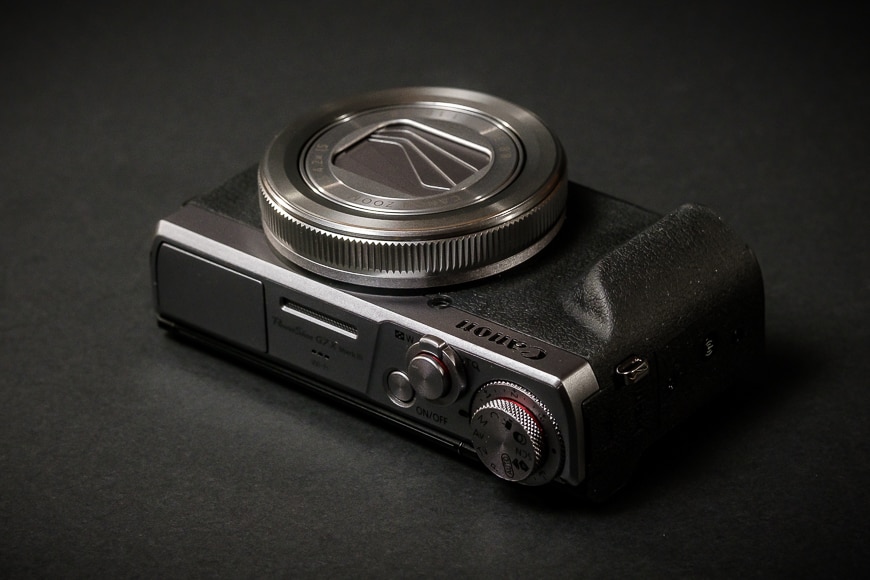
Tiny powerhouse of a camera that makes vlogging a dream.
This little G7X is a fully-fledged digital camera with a full range of aut0mated, manual and customisable options guaranteed to expand your creative output.
Plus, thanks to its brilliant zoom lens, it provides a flexible and portable solution for a whole range of photography styles and genres.
Let’s take a closer look at what Canon has managed to pack into the Powershot G7X Mark III with our extensive review.
Canon G7X Mark III Specs
- Neat and compact design
- Fully featured camera
- Perfect for vloggers
- Autofocus firmware fix
- Design is a little unbalanced
- Low light performance is soft
- Sensor: 20.1-megapixel 1″ stacked CMOS
- Continous: 30fps RAW burst
- Lens: 8.8-36.8mm (24-100mm) f/1.8-2.8
- Processor: Canon DIG!C 8
- Video:4K 30p, Full HD 120p
- Screen: 3″ Tilt Touchscreen with 3:2 aspect ratio and approx. 1,040k dots
- Dimensions: 105.5mm W x 60.9mm H x 41.4mmD (4.15″ x 2.39″ x 1.63″)
- Weight: 304g (0.67lb)
- Connectivity: WiFi & Bluetooth
- Image Stabilisation: 5-axis dynamic IS
Build & Appearance
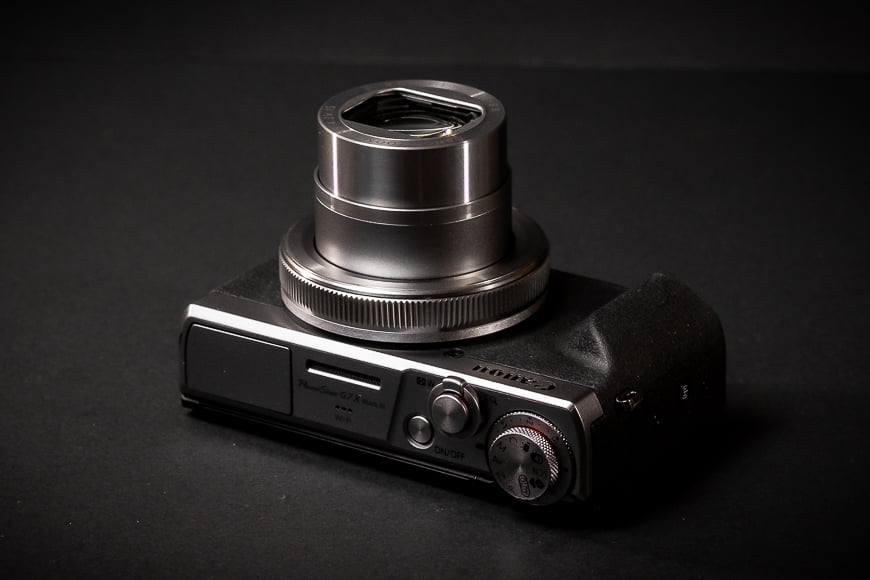
The zoom lens on the Canon G7X Mark III has a range of 24-100mm and a maximum aperture of f/1.8-2.8
Upon first glance, parts of the Canon G7X Mark III look like they’re made from cheap plastic components – particularly the ridged ring that circles the lens mount. And that’s a shame as once you pick it up and give it the once-over you realise that it’s actually quite a robust and well-built camera.
The camera’s width and height are less than the footprint of a standard smartphone, but it’s quite hefty at over 300g (o.6lb). The body of the camera feels solid in your hand with no sign of wobbly parts or internals.
I can understand people thinking it’s a cheap product as the main ring-housing for the lens system is prominent and has that tell-tale shine of plastic made to look like metal – at least in the silver version.
And, while the outer shell is all hardened-plastic, it’s very robust and feels solid.
The front of the camera is minimal, with the previously mentioned zoom lens system protruding from the body. This is enclosed by the large ring, and the front of the lens is protected from the elements with a leaf style closing cover.
This control ring and lens element dominate the front of the camera and if anything feels too large for the camera body.
Being a small compact camera, the grip is key to ensuring you keep it safe from drops. Fortunately, the body of the G7X Mark III is wrapped in a soft rubber skin that has a very fine grain-like texture that’s very grippy.
The G7X sports a nice sized grip that’s proportional to the size of the camera.
The top plate of the camera has a very neat and minimal look also. There’s a video mic that’s a long thin gap in the top plate with a mesh insert to prevent debris falling in – be sure to keep this clean of dust.
A pop-up fill flash is hidden inside the top plate of the camera and is ejected by a small switch to the side. While this is a neat addition, the hinging mechanism that supports the flash feels flimsy, and I’d hate to have it catch on something and break.
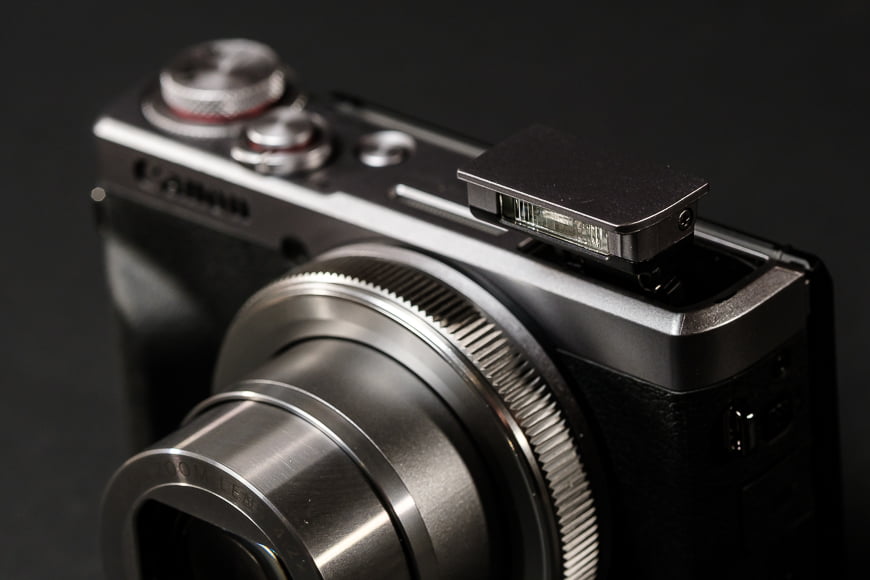
The Canon Powershot G7X Mark III has a nifty little pop-up flash.
The zoom selector, exposure compensation, and command dial all appear to be machined metal as they have a slightly different finish and feel much stronger. They’re a suitable size and have positive feedback and resistance when dialed.
The only remaining features are the counter-sunk ON/OFF button and three tiny holes for the speaker.
Looking at the side of the camera closest to the grip, there’s a single button with a Wi-Fi symbol that’s used for quick access to the connectivity menu.
Above this is a soft cover for the USB-C and HDMI mini port – great to see the use of USB-C for charging on the go and HDMI for recording to an external device too.
The other side of the camera has a switch to pop the flash, and below this is another softcover to hide the Mic port – very important for the use of external mics.
I like that the Canon G7X has a pair of camera strap lugs so you can hook up a neck strap and not just the usual flimsy wrist-strap pass-through lug found on a lot of compacts.
The base of the camera features a lockable door to access both the battery and the memory card slots. While the base is hardened-plastic, there’s a metal screw mount for tripod mounting.
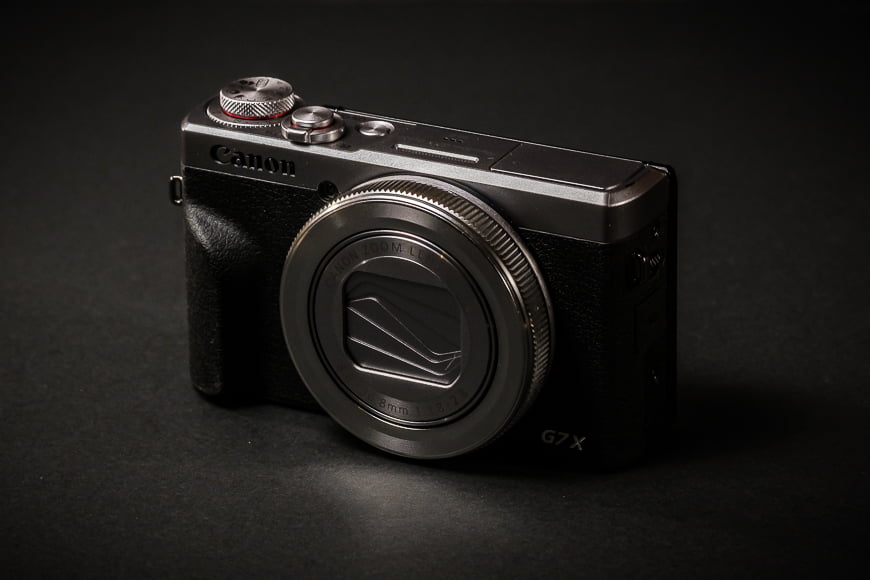
The Canon Powershot G7X Mark III has a great looking design; however, I feel like that control ring is oversized.
Finally, the rear of the Canon is dominated by the tilting touch screen, thumb rest, and a small selection of buttons. It has a great layout of minimal buttons and a control dial that’s also a four-direction pad with a Q button in the middle.
As for the screen, it tilts up 180 degrees making it perfect for selfie-style stills and especially vlogging – it also tilts down 45 degrees. The 3″ screen has a respectable 1,o40K dots of resolution, making it bright and detail-rich.
The screen’s alloy frame is robust and ensures that it sits flush against the back of the camera.
Lastly, the thumb grip has a ridge on both sides to ensure that your thumb stays where it belongs.
Overall, aside from the slightly nasty looking zoom ring on the front, the Canon G7X has a very neat and modern design
Ergonomics & Handling
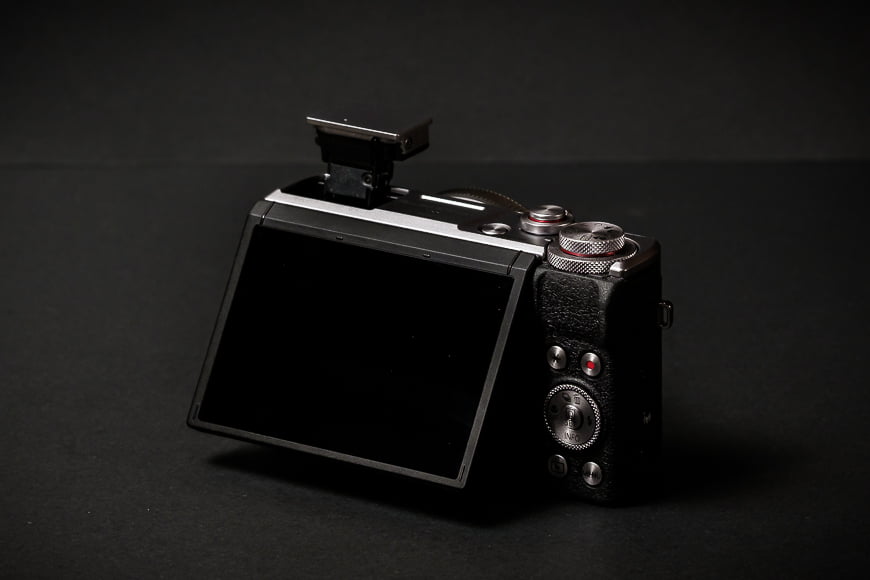
The overall layout of functions on the Canon Powershot G7X Mark III has been well designed with ergonomic considerations.
The Canon G7X is a premium compact camera, and as such, it needs to be both comfortable and intuitive to shoot with.
Plus, a camera of this style needs to be pocketable so that there’s always a temptation to take it with you wherever you go.
Fortunately, the G7X ticks all of those boxes as its diminutive size makes it a perfect camera for people that just want to throw it in their everyday bag or back pocket. Plus, for the vloggers out there, you can handhold this camera without a separate grip or gimble and experience zero fatigue.
All of the buttons on the camera are accessible and provide a nice level of positive feedback to let you know you have hit the mark. The Command Dial and Exposure Compensation dial feel great and are clearly marked, and both provide clicky-feedback as you turn them.
The front lens ring also has a nice clicky response and, depending on what shooting mode you are in, alters settings such as zoom, aperture, and shutter speed. I like that it’s a quick control function for fast changes.
Accessing the menu and settings of the G7X is available through either the use of the rear buttons or via the touch screen. I prefer the touchscreen in this case as I can see what I am selecting and get instant feedback from my taps.
The Canon menu system is simple to understand and fairly intuitive. It would perfectly suit someone new to photography, videography, or for those moving across from a smart device who will feel right at home.

The touch screen on the Canon Powershot G7X Mark III flips up 180-degrees, making it perfect for vlogging.
On-screen information is great, especially for those new to photography with a digital camera. Each twist of the command dial results in an on-screen message or icon explaining the mode.
A great example of this is when you switch to Auto mode, an icon appears that when pressed opens the Creative Assist menu.
This menu includes Presets, Background Blur, Brightness, Contrast, Saturation, Color Tones, and Monochrome options – each of these can also be adjusted. So even in ‘auto’ mode, you have a lot of choices and creative control.
Another nice touch is the ability to press the play button, which turns the camera on and displays your last viewed image or video.
What’s more, the touch screen can also be used for selecting focus points and triggering the shutter.
Overall, the Canon Powershot G7X is a clever, user-friendly camera with suitable ergonomic considerations for a portable camera.
Focus Performance

10mm | 1/500 | f/5.6 | ISO 400
Out of the box, it has to be said that the video autofocus performance of the Canon G7X Mark III is a little lackluster – especially in low light and with subject tracking in video mode.
Fortunately, Canon identified this and took measures to develop and release a firmware update in late 2019.
As a result, a new set of focus modes has been added with much-improved subject acquisition and face tracking. However, it’s still not where it needs to be in low light conditions for a camera of this quality and price range.
When shooting photos in low light, the on-screen focus squares that are automatically selected by the camera would land on odd items. I’d frame the composition with evident foreground subjects, and the focus selection would jump to the background – in better light, this was not an issue.
In good lighting conditions, the Canon performs well with snappy autofocus in both video and stills modes.
A nice value-add to the G7X Mark III is that thanks to the implementation of a touch screen focusing system, you can select your focus point and shot from the rear screen.
Although, there was some noticeable lag after taking the shot for the image preview to first appear and then disappear before you could take another shot. With the image-preview turned off, I was able to instantly select a focus point with one touch and then trigger the shutter with the next.
It would be nice to be able to quickly tap the screen the skip image preview and grab another shot instantly.
Low Light Performance

15mm | 1/30 | f/5.6 | ISO 6400 (Unedited to demonstrate low-light and ISO performance)
The Canon G7X has ok performance in low light settings. While it won’t win any awards for this category, it will certainly handle your next party or night out.
The lens features an aperture of t f/1.8 at the 24mm range and f/2.8 at the 100mm end. Either way, these are both nice wide apertures that are perfect for both subject separation and for low-light conditions.
It’s important to understand that the wider the aperture, the more light that will enter the lens to hit the camera sensor. Plus, the wider the aperture, the small the f-stop number will be.
ISO is the light sensitivity that’s controlled and allowed to hit the image sensor. With the Canon G7X Mark III, the ISO can go as high as 12800 with an expanded range of 25600.
Image Quality

25mm | 1/200 | f/2.8 | ISO 1600
The Canon Powershot G7X has the ability to shoot in RAW, compressed RAW, and of course, JPEG.
In-camera RAW to JPEG editing is a key feature that allows you to quickly share your edited images to your smart device for sharing over social media channels.

13mm | 1/2000 | f/2.2 | ISO 1600
JPEG images are vibrant, contrasty, and sharp, and RAW images give an adequate amount of latitude for those who want to experiment a bit in an image editor.
Obviously, due to the small sensor size, you can’t expect to be pulling back tons of detail from highlights and shadows in the RAW files, but this is to be expected in a compact camera.
All in all, the image quality of the G7X Mark III is impressive, and it’s easy to see why it’s such a popular camera at this price range.
Video Quality
The Canon G7X Mark III is all about vlogging and live streaming.
Fortunately, for you, the camera delivers great video quality with 4K at 30p with no crop and Full HD. There’s also a Full HD at 120p mode for fun cinematic slow motion – all at the touch of a dedicated video record button.
Transferring your video directly to a service such as YouTube is pretty simple. You can, of course, use the video stored on the memory card to transfer the footage to your computer – this way, you can edit it before you upload it.
But you can also transfer that footage (and images) from the camera to your smartphone via the Canon Camera Connect app and then on to YouTube.
Again, once you have completed the setup process, from there on, it’s as simple as hitting the connectivity button on the side of the camera.
One of the standout features of the Canon G7X is the ability to live stream directly to YouTube. What seems crazy is the included manual from Canon does not give you guidance on how to achieve this.

The Canon G7X Mark III has some great connectivity features, including live-streaming in HD.
To begin with, you are going to need a couple of critical things – a YouTube account that’s set up for live streaming and a good Wi-Fi connection with bandwidth to support HD content streaming.
The next step is to set up a Canon Image Gateway account – you can find information about this on the Canon website. Then, by hitting that connectivity button on the side of the camera, you can set up your services.
Just follow the on-screen directions and those on the Canon Image Gateway site to finish the process.
There are a few steps here, but just do a search for a YouTube tutorial on the subject, and you will be fine. Once you have it set up the first time, moving forward, the live streaming process is simple.
While the onboard Mic on the G7X is good, you can attach an external mic via the mic port on the side of the camera. To mount the Mic you are going to have to purchase a separate bracket of some sort as there’s no attachment point on the camera.
A brilliant feature of the camera is the image stabilisation options available for both stills and video.
The G7X features 5-axis image stabilisation or IS. Plus, there’s an additional Dynamic IS with two ‘strengths’ to boost the reduction of camera shake affecting your frame.
The Canon Powershot G7X Mark III is a great solution for those wanting to take their videography, vlogging, and streaming to the next level without an expensive or extensive setup.
Overall Performance
The Canon G7X is a solid performer, especially once the firmware update addresses some of those autofocus issues. Without it, it would have been hard to recommend it over other cameras in the same class.
Thanks to the connectivity features, and the Canon Connect app, the built-in Wi-Fi and Bluetooth allows you to instantly connect to your preferred device and share your images to your favourite social network sites.
It’s a camera that’s easy to pick up and shoot with a natural learning curve to master the control dial and really expand your photography experience.
And this is a really important function of cameras today. Being able to access Aperture Priority or Manual modes shouldn’t be the sole domain of photographers in the know.
With today’s technology, cameras should do more to help new photographers explore all that the process has to offer – it should be encouraging and not daunting.
One of the performance issues that users have been reporting is that the camera tends to overheat. Personally, I didn’t experience any such issues for the time that I was using the camera.
Being such a small compact body, I’d imagine that the camera would easily become hot while being handheld and shooting video.
The Canon G7X starts up quickly and is responsive to button and touch screen command gestures. As a result, having this camera in your everyday carry bag provides the opportunity to whip it out and snap away on a whim.
The power-driven zoom is swift enough but will never match a manual twist zoom.

8.8mm | 1/1600 | f/3.5 | ISO 125 (zoomed out to its widest point)

36.8mm | 1/1600 | f/3.2 | ISO 125 (zoomed in to its furthest point)
Value for Money
The Canon Powershot G7X Mark III is the kind of camera perfectly suited to a variety of users. The first group is going to be the YouTube-crowd who enjoy creating their own content either via live stream or a later download.
Then there’s the group that’s looking for a perfect holiday camera – thanks to the video quality and flexibility of a zoom lens, the G7X ticks all the boxes.
Finally, there are those that are looking to jump from a smartphone to a digital compact camera to step-up their photography game.
In all of those cases, the user is going to want a camera that’s great value for money and won’t break the bank. Fortunately, the Canon G7X Mark III is one such camera, as it’s currently going for around $750 (check here for the latest price),
When you consider the video and photography capabilities of this camera, that’s excellent value for money.
The G7X Mark III is not a flimsy simple point and shoot. It’s a robust creative’s tool ideal for taking complete control of the creative process each and every time.
Canon G7X Mark III Review | Conclusion
The Canon Powershot G7X Mark III is a fully-featured compact camera.
Canon has directed their efforts with this camera to appeal to two groups – those looking to move up from their smart device to a ‘real’ camera and those that are keen on vlogging and creating online video content for YouTube.
Fortunately, a much-needed firmware update corrected some really poor autofocus issues experienced with video – the biggest selling point of this camera.
With a robust build, comprehensive stills and video performance and some really clever connectivity features, the Canon G7X Mark III is a perfect choice.
Aside from the vlogging/YouTube folk, the G7X would also suit travelers or those that just need a handy everyday camera for capturing family events and moments.
While there are a couple of questionable design choices, overall, this is a neat and modern camera that’s comfortable and easy to use.

Tiny powerhouse of a camera that makes vlogging a dream.









